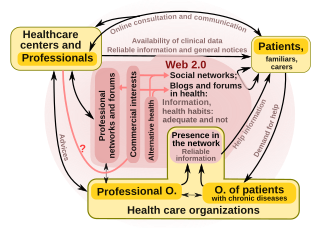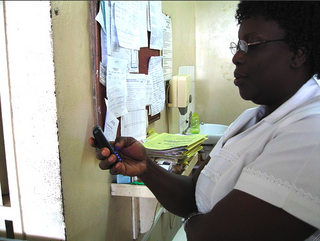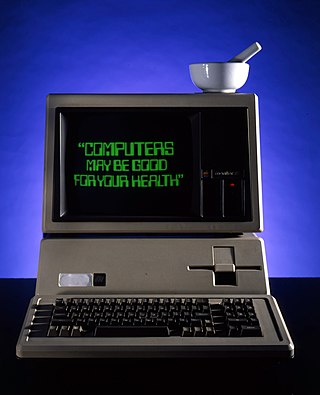Related Research Articles
In a support group, members provide each other with various types of help, usually nonprofessional and nonmaterial, for a particular shared, usually burdensome, characteristic. Members with the same issues can come together for sharing coping strategies, to feel more empowered and for a sense of community. The help may take the form of providing and evaluating relevant information, relating personal experiences, listening to and accepting others' experiences, providing sympathetic understanding and establishing social networks. A support group may also work to inform the public or engage in advocacy.

Health On the Net Foundation (HON) was a Swiss not-for-profit organization based in Geneva which promoted a code of conduct for websites providing health information and offered certificates to those in compliance.
eHealth describes healthcare services which are supported by digital processes, communication or technology such as electronic prescribing, Telehealth, or Electronic Health Records (EHRs). The use of electronic processes in healthcare dated back to at least the 1990s. Usage of the term varies as it covers not just "Internet medicine" as it was conceived during that time, but also "virtually everything related to computers and medicine". A study in 2005 found 51 unique definitions. Some argue that it is interchangeable with health informatics with a broad definition covering electronic/digital processes in health while others use it in the narrower sense of healthcare practice using the Internet. It can also include health applications and links on mobile phones, referred to as mHealth or m-Health. Key components of eHealth include electronic health records (EHRs), telemedicine, health information exchange, mobile health applications, wearable devices, and online health information. These technologies enable healthcare providers, patients, and other stakeholders to access, manage, and exchange health information more effectively, leading to improved communication, decision-making, and overall healthcare outcomes.
Public health surveillance is, according to the World Health Organization (WHO), "the continuous, systematic collection, analysis and interpretation of health-related data needed for the planning, implementation, and evaluation of public health practice." Public health surveillance may be used to track emerging health-related issues at an early stage and find active solutions in a timely manner. Surveillance systems are generally called upon to provide information regarding when and where health problems are occurring and who is affected.
WebCite is an on-demand archive site, designed to digitally preserve scientific and educationally important material on the web by taking snapshots of Internet contents as they existed at the time when a blogger or a scholar cited or quoted from it. The preservation service enabled verifiability of claims supported by the cited sources even when the original web pages are being revised, removed, or disappear for other reasons, an effect known as link rot.
An e-patient is a health consumer who participates fully in their own medical care, primarily by gathering information about medical conditions that impact them and their families, using the Internet and other digital tools. The term encompasses those who seek guidance for their own ailments, and the friends and family members who research on their behalf. E-patients report two effects of their health research: "better health information and services, and different, but not always better, relationships with their doctors."

Gunther Eysenbach is a German-Canadian researcher on healthcare, especially health policy, eHealth, and consumer health informatics.
The Journal of Medical Internet Research is a peer-reviewed open-access medical journal established in 1999 covering eHealth and "healthcare in the Internet age". The editors-in-chief are Gunther Eysenbach and Rita Kukafka. The publisher is JMIR Publications.
Online health communities are online social networks related to health. They primarily provide a means for patients and their families to learn about illnesses, to seek and offer social support, and to connect with others in similar circumstances. These online groups can be composed of individuals with illnesses, groups of medical professionals with shared interests, non-professional caregivers and family of patients, or a combination. The term "online health community" is primarily academic jargon.

"Health 2.0" is a term introduced in the mid-2000s, as the subset of health care technologies mirroring the wider Web 2.0 movement. It has been defined variously as including social media, user-generated content, and cloud-based and mobile technologies. Some Health 2.0 proponents see these technologies as empowering patients to have greater control over their own health care and diminishing medical paternalism. Critics of the technologies have expressed concerns about possible misinformation and violations of patient privacy.

mHealth is an abbreviation for mobile health, a term used for the practice of medicine and public health supported by mobile devices. The term is most commonly used in reference to using mobile communication devices, such as mobile phones, tablet computers and personal digital assistants (PDAs), and wearable devices such as smart watches, for health services, information, and data collection. The mHealth field has emerged as a sub-segment of eHealth, the use of information and communication technology (ICT), such as computers, mobile phones, communications satellite, patient monitors, etc., for health services and information. mHealth applications include the use of mobile devices in collecting community and clinical health data, delivery/sharing of healthcare information for practitioners, researchers and patients, real-time monitoring of patient vital signs, the direct provision of care as well as training and collaboration of health workers.
Health 3.0 is a health-related extension of the concept of Web 3.0 whereby the users' interface with the data and information available on the web is personalized to optimize their experience. This is based on the concept of the Semantic Web, wherein websites' data is accessible for sorting in order to tailor the presentation of information based on user preferences. Health 3.0 will use such data access to enable individuals to better retrieve and contribute to personalized health-related information within networked electronic health records, and social networking resources.
Infoveillance is a type of syndromic surveillance that specifically utilizes information found online. The term, along with the term infodemiology, was coined by Gunther Eysenbach to describe research that uses online information to gather information about human behavior.

The Wikipedia online encyclopedia has, since the late 2000s, served as a popular source for health information for both laypersons and, in many cases, health care practitioners. Health-related articles on Wikipedia are popularly accessed as results from search engines, which frequently deliver links to Wikipedia articles. Independent assessments have been made of the number and demographics of people who seek health information on Wikipedia, the scope of health information on Wikipedia, and the quality and reliability of the information on Wikipedia.

Health information on the Internet refers to all health-related information communicated through or available on the Internet.
Health Web Science (HWS) is a sub-discipline of Web Science that examines the interplay between health sciences, health and well-being, and the World Wide Web. It assumes that each domain influences the others. HWS thus complements and overlaps with Medicine 2.0. Research has uncovered emergent properties that arise as individuals interact with each other, with healthcare providers and with the Web itself.
Digital phenotyping is a multidisciplinary field of science, first defined in a May 2016 paper in JMIR Mental Health authored by John Torous, Mathew V Kiang, Jeanette Lorme, and Jukka-Pekka Onnela as the "moment-by-moment quantification of the individual-level human phenotype in situ using data from personal digital devices." The data can be divided into two subgroups, called active data and passive data, where the former refers to data that requires active input from the users to be generated, whereas passive data, such as sensor data and phone usage patterns, are collected without requiring any active participation from the user.
Digital medicine refers to the application of advanced digital technologies, such as artificial intelligence, machine learning, and big data analytics, to improve patient outcomes and healthcare delivery. It involves the integration of technology and medicine to facilitate the creation, storage, analysis, and dissemination of health information, with the aim of enhancing clinical decision-making, improving patient care, and reducing costs.
Health data is any data "related to health conditions, reproductive outcomes, causes of death, and quality of life" for an individual or population. Health data includes clinical metrics along with environmental, socioeconomic, and behavioral information pertinent to health and wellness. A plurality of health data are collected and used when individuals interact with health care systems. This data, collected by health care providers, typically includes a record of services received, conditions of those services, and clinical outcomes or information concerning those services. Historically, most health data has been sourced from this framework. The advent of eHealth and advances in health information technology, however, have expanded the collection and use of health data—but have also engendered new security, privacy, and ethical concerns. The increasing collection and use of health data by patients is a major component of digital health.
An infodemic is a rapid and far-reaching spread of both accurate and inaccurate information about certain issues. The word is a portmanteau of information and epidemic and is used as a metaphor to describe how misinformation and disinformation can spread like a virus from person to person and affect people like a disease. This term, originally coined in 2003 by David Rothkopf, rose to prominence in 2020 during the COVID-19 pandemic.
References
- 1 2 3 Eysenbach, Gunther (Dec 2002). "Infodemiology: The epidemiology of (mis)information". American Journal of Medicine. 113 (9): 763–5. CiteSeerX 10.1.1.8.8283 . doi:10.1016/s0002-9343(02)01473-0. PMID 12517369. S2CID 35788388.
- 1 2 Eysenbach, G (2006). "Infodemiology: tracking flu-related searches on the web for syndromic surveillance". AMIA ... Annual Symposium Proceedings. AMIA Symposium. 2006: 244–8. PMC 1839505 . PMID 17238340.
- ↑ Eysenbach, G (27 March 2009). "Infodemiology and infoveillance: framework for an emerging set of public health informatics methods to analyze search, communication and publication behavior on the Internet". Journal of Medical Internet Research. 11 (1): e11. doi: 10.2196/jmir.1157 . PMC 2762766 . PMID 19329408.
- ↑ "1st WHO Infodemiology Conference". www.who.int. Retrieved 2020-11-14.
- ↑ Eysenbach, Gunther. "The Infovigil Project". www.infodemiology.org. Archived from the original on 2017-01-23. Retrieved 2016-11-12.
- ↑ Ling, Rebecca; Lee, Joon (2016-10-12). "Disease Monitoring and Health Campaign Evaluation Using Google Search Activities for HIV and AIDS, Stroke, Colorectal Cancer, and Marijuana Use in Canada: A Retrospective Observational Study". JMIR Public Health and Surveillance. 2 (2): e156. doi: 10.2196/publichealth.6504 . PMC 5081479 . PMID 27733330.
- ↑ Eysenbach, Gunther (2003-01-01). "SARS and Population Health Technology". Journal of Medical Internet Research. 5 (2): e14. doi: 10.2196/jmir.5.2.e14 . PMC 1550560 . PMID 12857670.
- ↑ Hansen, N. D.; Mølbak, K.; Cox, I. J.; Lioma, C. (2018). "Seasonal Web Search Query Selection for Influenza-Like Illness (ILI) Estimation". arXiv: 1802.06833 [cs.IR]. Proceedings of the 40th International ACM SIGIR Conference on Research and Development in Information Retrieval, 1197-1200.
- ↑ Woo, Hyekyung; Cho, Youngtae; Shim, Eunyoung; Lee, Jong-Koo; Lee, Chang-Gun; Kim, Seong Hwan (2016-07-04). "Estimating Influenza Outbreaks Using Both Search Engine Query Data and Social Media Data in South Korea". Journal of Medical Internet Research. 18 (7): e177. doi: 10.2196/jmir.4955 . ISSN 1438-8871. PMC 4949385 . PMID 27377323.
- ↑ Lampos, Vasileios; Miller, Andrew C.; Crossan, Steve; Stefansen, Christian (2015-08-03). "Advances in nowcasting influenza-like illness rates using search query logs". Scientific Reports. 5: 12760. Bibcode:2015NatSR...512760L. doi:10.1038/srep12760. ISSN 2045-2322. PMC 4522652 . PMID 26234783.
- ↑ Hansen, N. D.; Mølbak, K.; Cox, I. J.; Lioma, C. (2017). "Time-Series Adaptive Estimation of Vaccination Uptake Using Web Search Queries". arXiv: 1702.07326 [cs.IR]. Proceedings of the 26th International Conference on World Wide Web, 773-774.
- ↑ Hansen, N. D.; Mølbak, K.; Cox, I. J.; Lioma, C. (2016). "Ensemble Learned Vaccination Uptake Prediction using Web Search Queries". arXiv: 1609.00689 [cs.IR]. Proceedings of the 25th ACM International on Conference on Information and Knowledge Management, 1953-1956.
- ↑ Hansen, N. D.; Mølbak, K.; Cox, I. J.; Lioma, C. (2018). "Predicting Antimicrobial Drug Consumption Using Web Search Data" (PDF). Proceedings of the 2018 International Conference on Digital Health. pp. 133–142. arXiv: 1803.03532 . Bibcode:2018arXiv180303532D. doi:10.1145/3194658.3194667. ISBN 978-1-4503-6493-5. S2CID 3801274. Archived from the original (PDF) on 2018-03-13. Retrieved 2018-03-12. Proceedings of the ACM International Conference on Digital Health 2018.
- ↑ Bragazzi, Nicola Luigi (2013-01-01). "Infodemiology and infoveillance of multiple sclerosis in Italy". Multiple Sclerosis International. 2013: 924029. doi: 10.1155/2013/924029 . ISSN 2090-2654. PMC 3762202 . PMID 24027636.
- ↑ Brigo, Francesco; Lochner, Piergiorgio; Tezzon, Frediano; Nardone, Raffaele (2014-07-01). "Web search behavior for multiple sclerosis: An infodemiological study". Multiple Sclerosis and Related Disorders. 3 (4): 440–443. doi:10.1016/j.msard.2014.02.005. ISSN 2211-0356. PMID 25877054.
- ↑ Chan, Kl; Ho, Sy; Lam, Th (2013-09-02). "Infodemiology of alcohol use in Hong Kong mentioned on blogs: infoveillance study". Journal of Medical Internet Research. 15 (9): e192. doi: 10.2196/jmir.2180 . ISSN 1438-8871. PMC 3785983 . PMID 23999327.
- ↑ Fernandez-Luque, Luis; Karlsen, Randi; Bonander, Jason (2011-01-01). "Review of Extracting Information From the Social Web for Health Personalization". Journal of Medical Internet Research. 13 (1): e15. doi: 10.2196/jmir.1432 . PMC 3221336 . PMID 21278049.
- ↑ Kim, Yoonsang; Huang, Jidong; Emery, Sherry (2016-02-26). "Garbage in, Garbage Out: Data Collection, Quality Assessment and Reporting Standards for Social Media Data Use in Health Research, Infodemiology and Digital Disease Detection". Journal of Medical Internet Research. 18 (2): e41. doi: 10.2196/jmir.4738 . ISSN 1438-8871. PMC 4788740 . PMID 26920122.
- ↑ Bragazzi, Nicola Luigi; Bacigaluppi, Susanna; Robba, Chiara; Nardone, Raffaele; Trinka, Eugen; Brigo, Francesco (2016-02-01). "Infodemiology of status epilepticus: A systematic validation of the Google Trends-based search queries". Epilepsy & Behavior. 55: 120–123. doi:10.1016/j.yebeh.2015.12.017. ISSN 1525-5069. PMID 26773681. S2CID 205757762.
- ↑ Brigo, Francesco; Otte, Willem M.; Igwe, Stanley C.; Ausserer, Harald; Nardone, Raffaele; Tezzon, Frediano; Trinka, Eugen (2015-12-01). "Information-seeking behaviour for epilepsy: an infodemiological study of searches for Wikipedia articles". Epileptic Disorders. 17 (4): 460–466. doi:10.1684/epd.2015.0772. ISSN 1950-6945. PMID 26575365.
- ↑ Schäfer, Florent; Faviez, Carole; Voillot, Paméla; Foulquié, Pierre; Najm, Matthieu; Jeanne, Jean-François; Fagherazzi, Guy; Schück, Stéphane; Le Nevé, Boris (2020-11-03). "Mapping and Modeling of Discussions Related to Gastrointestinal Discomfort in French-Speaking Online Forums: Results of a 15-Year Retrospective Infodemiology Study". Journal of Medical Internet Research. 22 (11): e17247. doi: 10.2196/17247 . ISSN 1438-8871. PMC 7671840 . PMID 33141087.
- ↑ Ayers, John W.; Westmaas, J. Lee; Leas, Eric C.; Benton, Adrian; Chen, Yunqi; Dredze, Mark; Althouse, Benjamin M. (2016-06-01). "Leveraging Big Data to Improve Health Awareness Campaigns: A Novel Evaluation of the Great American Smokeout". JMIR Public Health and Surveillance. 2 (1): e16. doi: 10.2196/publichealth.5304 . PMC 4869240 . PMID 27227151.
- ↑ "Even the most mundane online social commentary can have a purpose". The Irish Times. Retrieved 2016-11-12.
- ↑ Blastland, Michael (2010-12-14). "What do Google, Ask and Bing search results mean?". BBC News. Retrieved 2016-11-12.
- 1 2 "Infodemic".
- 1 2 https://infodemiology.jmir.org/
- 1 2 "1st WHO Infodemiology Conference".